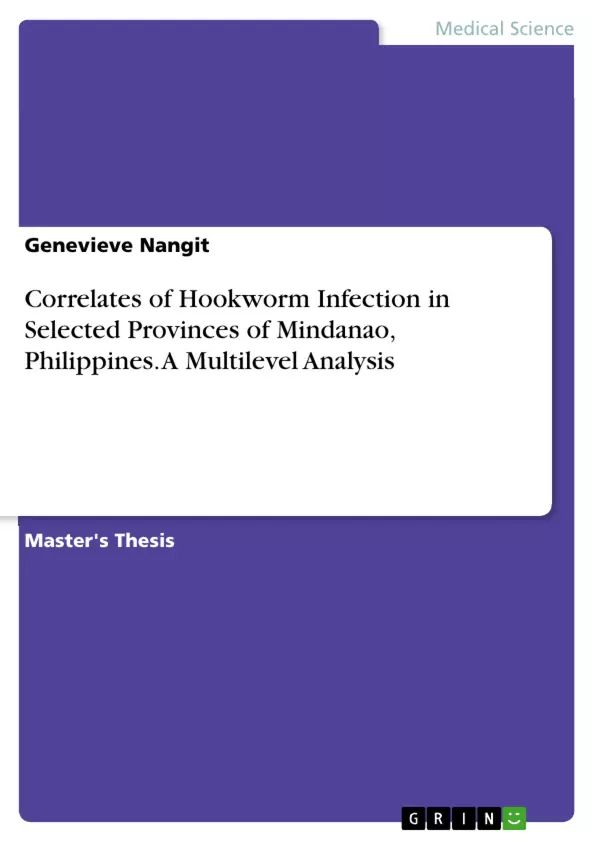The risk factors for hookworm infection are multi-factorial and they operate on different levels. Typical analyses of hookworm infection disparities have focused largely on either individual- or ecologic-level determinants, and none has analyzed them on both levels simultaneously. Hence, this study aimed to fill the need of simultaneously analyzing the correlates of hookworm infection on different levels, using the multilevel model.
The general objective of the study was to identify the individual-level, barangay-level and provincial-level factors associated with hookworm infection in selected provinces in Mindanao. This thesis was a cross-sectional study that uses several secondary datasets. Individual-level variables were age, gender and hookworm infection status. The level 2 variables were land cover type (or also known as vegetation), barangay income classification, literacy rate and percentage of households without any form of toilet facility. The level 3 variables were climate type, average monthly rainfall and average monthly maximum temperature. The Mindanao provinces that were included in the study were Agusan del Sur, Davao del Sur, South Cotabato, Surigao del Sur, Misamis Oriental, Bukidnon, Surigao del Norte.
Descriptive and crude analyses of hookworm infection were done using Microsoft Excel 2007 and Stata 10. Multilevel modeling was done using the Generalized Linear Latent and Mixed Models (GLLAMM) in Stata. The significant correlates of hookworm infection at the individual level are older age and male gender. While at the barangay level, it is a predominantly cultivated land cover. At the provincial level, these are average rainfall ≥100mm during LAR, average rainfall ≤100mm during HAR and Type 3 climate (seasons are not very pronounced). The significant factors at the barangay and provincial level can be used as criteria for selecting target areas for specific STH interventions. The STH interventions, which is primarily deworming, could expand its coverage and include as beneficiaries the older individuals.
Inhaltsverzeichnis (Table of Contents)
- CHAPTER I INTRODUCTION
- 1.1 Background of the Study
- 1.2 Statement of the Problem
- 1.3 Objectives of the Study
- 1.4 Significance of the Study
- CHAPTER II THEORETICAL BACKGROUND
- 2.1 Review of Related Literature
- 2.1.1 Etiology and Pathophysiology of Hookworm Infection
- 2.1.2 Health Impact of Hookworm Infection
- 2.1.3 Determinants of Hookworm Infection
- 2.1.4 Multilevel Analysis
- 2.2 Conceptual Framework
- CHPATER III METHODOLOGY
- 3.1 Research Design
- 3.2 Sources of Data
- 3.2.1 Prevalence Survey for Schistosomiasis
- 3.2.2 The Group-Level Datasets
- 3.3 Study Areas and Number of Respondents
- 3.4 Definition of Variables
- 3.5 Data Processing
- 3.6 Data Analysis
- 3.6.1 Descriptive Analysis
- 3.6.2 Inferential Analysis
- CHAPTER IV RESULTS OF THE STUDY
- 4.1 Descriptive Analysis
- 4.1.1 First-level Variables
- 4.1.2 Second-level Variables
- 4.1.3 Third-level Variables
- 4.1.4 Hookworm Prevalence
- 4.2 Inferential Analysis
- 4.2.1 Crude Association of Hookworm Infection With Individual-Level Variables
- 4.2.2 Crude Association of Hookworm Infection With Barangay-Level Variables
- 4.2.3 Crude Association of Hookworm Infection with Provincial-Level Variables
- 4.2.4 Multilevel Modeling
- CHAPTER V DISCUSSION OF RESULTS
- 5.1 Analytic Techniques
- 5.1.1 Barangay-level variability of risk for hookworm infection
- 5.2 Correlates of hookworm infection
- 5.2.1 Individual-level correlates
- 5.2.2 Barangay-level correlates
- 5.2.3 Provincial-level correlates
- 5.3 Validity
- 5.3.1 Selection Bias
- 5.3.2 Information Bias
- 5.3.3 Confounding
Zielsetzung und Themenschwerpunkte (Objectives and Key Themes)
This thesis aims to investigate the correlates of hookworm infection in selected provinces of Mindanao, Philippines, using a multilevel analysis approach. The study explores the factors contributing to hookworm infection at individual, barangay (village), and provincial levels. * **Hookworm infection and its determinants:** The study focuses on understanding the factors influencing hookworm infection in the selected provinces. * **Multilevel analysis:** The thesis utilizes a multilevel analysis framework to examine the relationships between hookworm infection and various factors at different levels. * **Health impact of hookworm infection:** The study investigates the health implications of hookworm infection in the study population. * **Geographic variation in hookworm infection:** The thesis explores the spatial distribution of hookworm infection across the selected provinces of Mindanao.Zusammenfassung der Kapitel (Chapter Summaries)
- **Chapter I: Introduction:** This chapter establishes the background of the study, outlining the prevalence of hookworm infection in the Philippines and highlighting the health burden it poses. It defines the research problem, states the objectives, and emphasizes the significance of the study.
- **Chapter II: Theoretical Background:** This chapter provides a comprehensive review of the literature related to hookworm infection, covering its etiology, pathophysiology, health impact, and determinants. It discusses the importance of multilevel analysis in understanding the complexities of hookworm infection and presents the study's conceptual framework.
- **Chapter III: Methodology:** This chapter details the study design, data sources, study areas, definition of variables, data processing, and data analysis techniques. It explains the multilevel analysis approach used to examine the correlates of hookworm infection.
- **Chapter IV: Results of the Study:** This chapter presents the results of the descriptive and inferential analysis, examining the association of hookworm infection with various individual, barangay, and provincial-level variables. It includes information on the prevalence of hookworm infection and the factors contributing to its variation across different levels.
- **Chapter V: Discussion of Results:** This chapter interprets the findings of the study, analyzing the relationships between hookworm infection and its correlates. It discusses the significance of the results in terms of public health implications and provides insights into the factors influencing hookworm infection.
Schlüsselwörter (Keywords)
This study focuses on the prevalence and correlates of hookworm infection in Mindanao, Philippines, employing multilevel analysis. Key terms and concepts include hookworm infection, multilevel analysis, determinants of hookworm infection, individual-level factors, community-level factors, provincial-level factors, health impact, and public health implications. The research utilizes data from a prevalence survey for schistosomiasis and group-level datasets to explore the geographic variation and factors associated with hookworm infection in the region.- Citation du texte
- Genevieve Nangit (Auteur), 2017, Correlates of Hookworm Infection in Selected Provinces of Mindanao, Philippines. A Multilevel Analysis, Munich, GRIN Verlag, https://www.grin.com/document/421618



